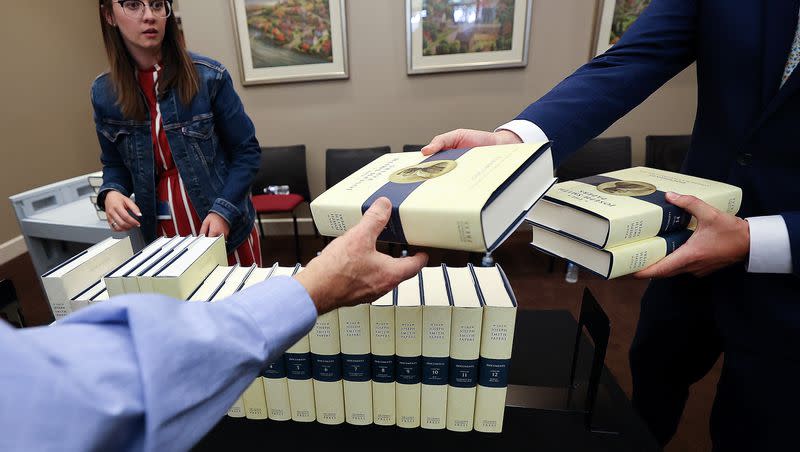7 insights about Latter-day Saint women’s history from the Joseph Smith Papers

- Oops!Something went wrong.Please try again later.
- Oops!Something went wrong.Please try again later.
Over two decades and 27 volumes later, the final volume of the Joseph Smith Papers released on June 27.
Historians transcribed and provided commentary on thousands of historical records — from journals to manuscripts to legal cases — housed both in volumes published by the Church Historian’s Press and available online at JosephSmithPapers.org.
The Joseph Smith Papers includes “documents that were created by Joseph Smith, whether written or dictated by him or created by others under his direction, or that were owned by Smith, that is, received by him and kept in his office,” the FAQ for Joseph Smith Papers said.
Ranging from speeches Joseph Smith gave to the Relief Society to accounts of women participating in The Church of Jesus Christ of Latter-day Saints, the Joseph Smith Papers offers insight into the early history of Latter-day Saint women.
Here’s seven insights about Latter-day Saint women’s history from the Joseph Smith Papers.
Related
1. Emma Smith as ‘an elect lady’
Now known as Doctrine and Covenants 25, this revelation was originally titled “27th Commandment AD 1830.” In a revelation given through Joseph Smith, Emma Smith is told, “Behold thy sins are for given thee & thou art an Elect Lady whom I have called.”
This revelation forecasts Emma Smith’s role as the first Relief Society president.
She’s also told “to make a selection of Sacred Hymns,” which becomes the hymnal early Latter-day Saints used.
2. Establishment of the Relief Society
The Relief Society, a Latter-day Saint women’s organization oriented toward community service, was organized on March 17, 1842.
The meeting minutes from the day it was established are contained in the Joseph Smith Papers. The meeting began when the group sang the hymn “The Spirit of God” and then the society was established.
Twenty women, including Emma Smith, Elizabeth Ann Whitney and Eliza R. Snow. were present and admitted into the society. Another six were also admitted.
At the meeting, Joseph Smith said the purpose of the Relief Society was to create a community to serve the poor, preserve morality and strengthen virtue.
3. The Relief Society is described as an important organization
After its formation, the Relief Society began making significant strides to help the poor. Joseph Smith saw the organization as having the ability to contribute a lot of good.
In a discourse on April 28, 1842 in Nauvoo, Illinois, Eliza R. Snow recorded Joseph Smith saying, “I now deliver it as a prophecy that before ten years shall roll round, the queens of the earth shall come and pay their respects to this Society — they shall come with their millions and shall contribute of their abundance for the relief of the poor.”
Later, the Relief Society and, in particular, a Latter-day Saint women’s publication known as the Woman’s Exponent would be key in women receiving the right to vote in Utah.
Related
4. Women were included in voting on church matters
Documents like the minutes from a Nov. 7, 1837, meeting at Far West, Missouri, specify that women were included in voting on church business matters. In 19th-century America, women were typically not allowed to teach from the pulpit and had limited public participation in religion.
The church was reorganized in Kirtland and “all were requested, (males and females), to vote,” the transcript says.
5. Women were also scribes.
Women like Martha Jane Knowlton Coray and Eliza R. Snow were among the female scribes who recorded historical accounts from Lucy Mack Smith, discourses from Joseph Smith and other documents.
Their work to scribe documents led to the documents existing to become part of the Joseph Smith Papers.
6. Women were focusing on helping the poor.
The minutes from Relief Society meetings provide insight into what work and service women were doing at the time.
At the meeting on March 24, 1842, Mary Smith said, “nothing was more laudable than feeding the hungry, clothing the naked &c. — that she desired to aid in accomplishing objects so generous.”
According to the meeting minutes, Lucy Smith said, “she was advanc’d in years and could not stay long — hop’d the Lord would bless and aid the Society in feeding the hungry, clothing the naked — that her work was nearly done — felt to pray that the blessings of heaven might rest upon the Society.”
Related
7. Women helped to build the temple.
The Kirtland Temple was built in part because of donations. One such donation came from Vienna Jacques, who moved from Boston to be with the Latter-day Saints after she was converted to the church from a Methodist Episcopal church. She donated a generous amount, which contributed to the building of the temple.
Joseph Smith wrote a letter to acknowledge her contribution. “I have often felt a whispering since I received your letter, like this Joseph thou art indebted to thy God for the offering of thy Sister Viana (Vienna Jaques) which proved a Savior of life.”
Jacques is told she “should not be forgotten.”
Joseph Smith Papers conference
The Joseph Smith Papers contained other insights about women’s history as well. At a 2023 conference commemorating the completion of the project, which will be held on Sept. 15-16, there’s a panel called “Women, Gender, and Family in Joseph Smith’s America.”
Scholars Kathleen Flake, Sarah M.S. Pearsall and Laurel Thatcher Ulrich will deliver their papers on: “Temple, Priesthood, and the Joseph Smith Papers,” “Plural Marriage and the Joseph Smith Papers” and “The Nauvoo Relief Society and the Myth of Seneca Falls: New Insights from the Joseph Smith Smith Papers Project.”
More information about the conference can be found on the Joseph Smith Papers website.

